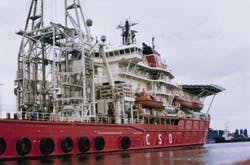WELL SERVICING Multipurpose vessels gaining favor for lower cost well intervention
CSO Seawell with wellservicing derrick.North Sea operators are looking to reduce costs of planned well intervention/workover programs. An operation involving equipment retrieval and changeout typically calls for a DSV and anchorhandler supporting a mobile drilling rig.
Some contractors, however, are using one multipurpose support vessel to handle the work alone. One such is the dynamically positioned monohull CSO Seawell, currently working through a busy winter schedule ranging from tree replacement to well abandonment. Its onboard equipment includes a purpose-built workover derrick with heave compensation and guideline systems.
Last month the vessel was removing two producing wells and one suspended well under Lasmo's subsea Staffa Field abandonment programme. Production had to be terminated due to unavoidable build up of hydrates.
The Seawell was then due to move to Enterprise's Nelson and Agip's Toni for well servicing, followed by a third recent assignment for Amerada Hess on Fife. The other two were performed late last year under CSO's Moray Firth `timeshare' agreement, which also takes in Texaco and Elf Enterprise.
In partnership with Camco, which provided the subsea wireline lubricator, the Seawell first pulled and replaced a National subsea christmas tree on Amerada's Ivanhoe IK28 production well (the field has been producing oil and gas since 1989 through a subsea manifold tied back to the semisub FPS AH001).
Installation of the replacement tree (also National) is thought to be the first performed by a DP monohull anywhere. Coflexip Stena Offshore set plugs and killed the well before disconnecting the in-place tree and removing it for refurbishment. After the replacement tree was installed, production logging and reperforating of the well was performed followed by setting of mechanical and cement plugs.
In December, the Seawell moved to Amerada's Scott A4 well, part of the Scott Field's western production cluster, for a nine and a half day stint. The main operation was logging to identify water-bearing zones in the reservoir, which were isolated using a mechanical plug. The well was then reperforated and logged again.
For this exercise, the Camco lunbricator was upgraded to handle the 10,000psi well pressure. According to Camco's Roger Pollock, it is the only unit of its kind that can work to such a specification. The lubricator is now suitable for wireline intervention on all except very high pressure subsea wells, he claimed.
As with Ivanhoe, a key factor in choosing the Seawell was not having to mobilise a rig with attendant anchorhandler. Another advantage is the vessel's virtual all-weather working capability.
Last year an analysis was performed of the relative motions of the vessel in relation to its guidewires. Even in rough seas, said a CSO spokesman, "we found it was possible to allow the vessel to rotate more, without problems, allowing us to keep it by the well without having to disconnect".
The Seawell proved its durability by undertaking downhole work for Arco on the Welland Field last October in 50 knot winds, in a busy shipping lane. This was also the vessel's first Southern North Sea intervention exercise.
Copyright 1996 Offshore. All Rights Reserved.



